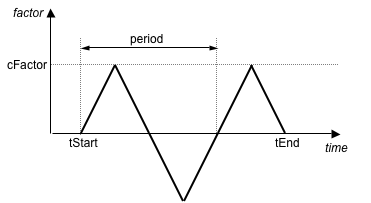Triangular TimeSeries: Difference between revisions
Jump to navigation
Jump to search
No edit summary |
No edit summary |
||
| (6 intermediate revisions by the same user not shown) | |||
| Line 1: | Line 1: | ||
{{CommandManualMenu}} | {{CommandManualMenu}} | ||
This command is used to construct a TimeSeries object in which the load factor is some triangular function of the time in the domain | This command is used to construct a TimeSeries object in which the load factor is some triangular function of the time in the domain. | ||
{| | {| | ||
| style="background:yellow; color:black; width:800px" | '''timeSeries Triangle $tag $tStart $tEnd $period <-shift $shift> <-factor $cFactor> | | style="background:yellow; color:black; width:800px" | '''timeSeries Triangle $tag $tStart $tEnd $period <-shift $shift> <-factor $cFactor> | ||
|} | |} | ||
---- | ---- | ||
| Line 32: | Line 22: | ||
| '''$cFactor''' || the load amplification factor (optional, default = 1.0) | | '''$cFactor''' || the load amplification factor (optional, default = 1.0) | ||
|} | |} | ||
[[Image:TriangularTimeSeries.png]] | |||
Latest revision as of 22:03, 2 September 2012
- Command_Manual
- Tcl Commands
- Modeling_Commands
- model
- uniaxialMaterial
- ndMaterial
- frictionModel
- section
- geometricTransf
- element
- node
- sp commands
- mp commands
- timeSeries
- pattern
- mass
- block commands
- region
- rayleigh
- Analysis Commands
- Output Commands
- Misc Commands
- DataBase Commands
This command is used to construct a TimeSeries object in which the load factor is some triangular function of the time in the domain.
| timeSeries Triangle $tag $tStart $tEnd $period <-shift $shift> <-factor $cFactor> |
| $tag | unique tag among TimeSeries objects |
| $tStart | starting time of non-zero load factor |
| $tEnd | ending time of non-zero load factor |
| $period | characteristic period of triangular wave |
| $shift | phase shift in seconds (optional, default = 0.0) |
| $cFactor | the load amplification factor (optional, default = 1.0) |
Code Developed by: Andreas Schellenberg, University of California, Berkeley.
